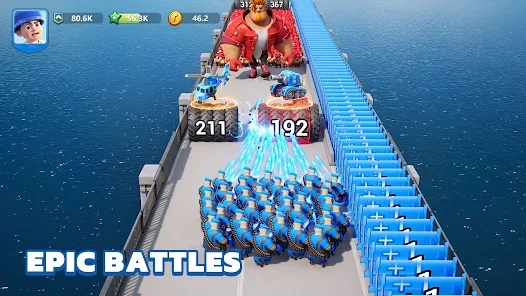Why Idle Games are Revolutionizing the Experience of Life Simulation Games
In the vast universe of gaming, there's a trend that's subtly but profoundly transforming how we engage with life simulation games: idle games. These innovative creations are not just games; they're whole experiences that resonate with our desire for casual entertainment while offering a sprinkle of life management. In this article, we’ll explore why idle games are sweeping the chart, especially in the arena of life simulation games, and how they compare with other popular genres like match 3 crash.
What are Idle Games?
At their core, idle games (or incremental games) let players progress without the constant need for active participation. They're designed to be played casually, allowing players to leave the game running while they attend to other tasks. This unique mechanic is what makes them special. But why are they so appealing in the context of life simulation games?
The Allure of Casual Gameplay
Life simulation games often require ongoing attention and strategy, making idle games a refreshing change. Players can interact with their simulated lives without the stress of maintaining constant focus. This gentle approach to gameplay allows for a laid-back experience that resonates with busy lifestyles. Plus, the progression feels gratifying, even if you’re not actively playing!
The Blend of Simulation and Idleness
Idle games translate complex life scenarios into simplified, digestible chunks. The growing interest in minimal-effort entertainment has aligned perfectly with the immersive nature of life simulation games. Instead of micromanaging every aspect of daily routines, players can focus on larger goals while the game effectively manages the smaller details. This duality creates a unique gameplay blend that keeps players engaged.
Key Features of Idle Life Simulation Games
- Automation: Automated actions are a hallmark of idle games. You can set up operations within the game that run in the background, reflecting real-life processes like cooking or crafting.
- Progression Systems: Many games incorporate leveling systems that reward players even when not playing actively, echoing the satisfaction of life achievements.
- Resource Management: Players need to gather resources, whether virtual or in-game currency. This mirrors real life, making them relatable.
Comparative Analysis: Idle Games vs. Other Genres
| Feature | Idle Games | Life Simulation Games | Match 3 Crash Games |
|---|---|---|---|
| Gameplay Style | Casual & Minimalist | Strategic & In-depth | Puzzle-Oriented |
| Player Engagement | Low Requirement | High Requirement | Medium Requirement |
| Goal Orientation | Passive Progression | Active Management | Score Maximization |
Community and Interaction
One might wonder how idleness fosters community interaction. Surprisingly, idle games often have vibrant communities! Players share tips and strategies online, creating a social network that thrives on shared experiences—critical for the success of any life simulation game.
The Rise of Mobile Idle Games
With mobile gaming booming, idle games have found a solid footing. They're perfectly suited for quick bursts of play on the go. Not to mention, they cater to the "play whenever" mentality of today's gamers. Imagine this: you're waiting for a friend, and rather than scrolling through social media, you check on your virtual garden—definitely a win, right?
Why Players Continue to Choose Idle Games
The satisfaction derived from watching numbers go up and progress happen naturally attracts a massive player base. It's also an excellent avenue for stress relief. Watching your characters thrive, cities grow, or resources accumulate without fingers constantly clicking offers a soothing experience that many crave in this fast-paced world.
Challenges and Limitations
Of course, idle games are not without their challenges. Some critics argue that they can become mindless and repetitive over time, leading to boredom. But many developers are working hard to introduce new features, events, and challenges to keep players engaged. So how can developers maintain excitement?
Innovative Solutions for Enhanced Engagement
- Seasonal Events: Incorporate events that coincide with real-world holidays, creating unique gameplay experiences.
- Diverse Challenges: Regularly introduce new challenges that require players' active engagement.
- Collaborations: Partner with popular IPs to bring exciting crossover content.
Tips for New Players
If you're new to idle games or life simulation games, here are some key points to keep in mind:
- Start Slow: Don't rush! Learn the mechanics before diving into advanced strategies.
- Explore: Try different idle games to find what resonates with you.
- Join the Community: Engage with forums and social media groups for tips and support.
Conclusion
The world of idle games is indeed transforming the landscape of life simulation games in ways we never imagined. By offering a blend of automation and engagement, they cater to our need for relaxation while fostering a sense of accomplishment. Whether you’re managing a farm, running a business, or monitoring the relationships of your characters, there's an idle game out there waiting for you to discover. Embrace the process and see how it revolutionizes your gaming experience!
FAQ
1. What defines an idle game?
Idle games allow players to simulate progress without constant interaction, often focusing on automation and passive play.
2. How do idle games relate to life simulation?
Both genres often emphasize resource management and player engagement, but idle games do so with a more relaxed approach.
3. Can you actively participate in idle games?
Yes! While they're designed for passive gameplay, many players enjoy checking in regularly to optimize their strategies.
4. Are idle games available on mobile devices?
Absolutely! Many idle games are designed specifically for mobile, making them accessible anytime, anywhere.



